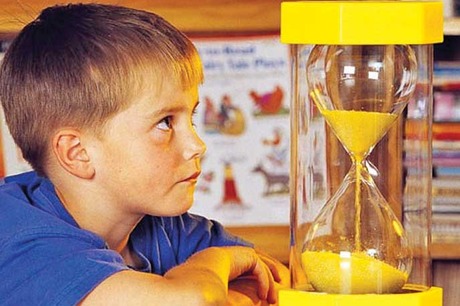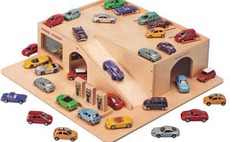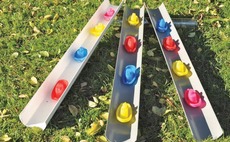
Children's understanding of fast and slow can be developed in a variety of ways that are relevant and age appropriate. They can explore different forms of transport and the speed at which vehicles move, they can use their bodies to run fast like a cheetah or slow like a tortoise, they can beat a drum rapidly or shake a tambourine gently, or explore their vocal chords and hands to sing and clap to the changing pace of music.
Practitioners can also offer children the chance to explore the concept of fast and slow though resources offering scientific and mathematical exploration. This might be rolling balls and toy cars down guttering, for example, or using sieves or plastic bottles with different-sized holes to watch how fast the sand and water flows out.
STEP-BY-STEP LEARNING
Linda Thornton, early years adviser to Reflections on Learning (Morley's of Bicester) and former primary adviser for science and design technology, says, 'Exploration and investigation is fundamental to young children's growing understanding of the world around them. As they begin to move out into the wider community, children begin to see people and things on the move in different ways and at different speeds. They learn to move faster and slower themselves, to make toys and other objects move and to navigate spaces and different environments safely.'
While the concepts associated with understanding speed and its effects are more appropriate for older children, Ms Thornton says that very young children will 'notice what happens when toys are pushed hard, wound up and let go, or rolled down a slope or along different surfaces'.
She adds, 'Past research has shown us that boys are particularly interested in movement - of themselves and other things - and exploring the theme of fast and slow will engage the interest of boys in particular.'
Linda Keats, workforce development consultant for Essex County Council early years and childcare, says that we should never underestimate children's ability to grasp concepts early, but that it is important that the learning is at an 'age-appropriate level' that is 'relevant' to the children's everyday lives.
She explains, 'Even the more advanced concepts can be introduced in a way that children can experience and investigate. Singing a familiar song at a fast pace and then slowing it down gives the children a real-life experience of fast and slow. Likewise, they can explore fast and slow through whole-body experiences - walking, running, rolling and crawling - and even blinking, breathing and clapping.'
SCAFFOLDING LEARNING
Building on what the children already know and extending it with new knowledge is known as scaffolding. Practitioners have a key role to play in extending children's learning and one of the ways that they can do this when it comes to fast and slow is by adding appropriate resources.
Ms Keats explains, 'Guttering stands are a perfect platform for experimenting with fast and slow through gradients. Try rolling heavy or light objects down the tubes. Adults can extend the learning with questions like, "Will the heavy object roll faster or slower?" When I've done this with children at the nursery, it has taken the learning to a whole different level - and their knowledge and problem-solving abilities have amazed us.'
Fast and slow can also be explored through science. For example, children can observe what happens when hot or cold water is added to melting ice, or watch how fast or slow the water flows from a plastic bottle with different-sized holes at the bottom. Ms Keats explains, 'Again, this is a real-life experiment that children can actually experience and try out for themselves. What better way to learn than to actually do?'

ACTIVITIES AND RESOURCES
Here are some examples of activities and resources to include in your fast and slow collection:
- Children enjoy playing games that involve timing how long it takes to do something, or seeing if they can speed up an activity. Try using a sand timer or stopwatch at tidy-up time. The Tickit Mega Sand Timer (£29.99) and the Pack of 6 Tickit Easy Timers (£14.99) are available at www.reflectionsonlearning.co.uk. Or try the digital Jumbo Touch Screen Timer (£11.49) from Cosy Direct on 01332 370152.
- Provide resources to create ball runs, waterways and slopes for vehicles. The smaller balls from Hope Education's Ball Value Pack (78.70) can be used with its Full Tube Channelling Set (29.95), www.hope-education.co.uk. Or Cosy Direct has a range of guttering and tubes that are ideal for experimenting with balls, water and toys. Use the Spaghetti Junction Set (£69.99) to arrange guttering at different heights and directions. Or have boat races to explore gradients and water with a pack of 24 Guttering Friendly Boats (£9.99), used with the Fence 'Anti Droop' Guttering (£19.95). Try the pack of six Smaller Nesting Crates (£37.25) with the set of two Rustic Planks (£13.95), to create runways at different gradients.
 Allow children to create their own channels with the Creative Cascade Set (£199.95) from www.ttsgroup.co.uk, which contains stands, six pipes, and three connectors to extend the pipes for longer channels if required. Or use the Bamboo Water Channelling Set (£93.59) from www.earlyyears.co.uk, which includes eight crates, four half bamboo tubes and four full bamboo tubes, to zoom cars down or roll balls down. On a smaller scale, the Wooden Marble Run (£64.89) from www.earlyyears.co.uk comes with 42 pieces of beech wood, six marbles and a ringing bell.
Allow children to create their own channels with the Creative Cascade Set (£199.95) from www.ttsgroup.co.uk, which contains stands, six pipes, and three connectors to extend the pipes for longer channels if required. Or use the Bamboo Water Channelling Set (£93.59) from www.earlyyears.co.uk, which includes eight crates, four half bamboo tubes and four full bamboo tubes, to zoom cars down or roll balls down. On a smaller scale, the Wooden Marble Run (£64.89) from www.earlyyears.co.uk comes with 42 pieces of beech wood, six marbles and a ringing bell.
- Help children understand the importance of exercise and movement for healthy and safe living by encouraging them to practise controlled slow movements and moving safely at speed. Setting personal goals for how quickly they can move in different ways will appeal to some children.
- Use the opportunities presented by fast and slow to reinforce messages about road safety and navigating the indoor and outdoor spaces in your setting safely, particularly using wheeled vehicles. Experiment with wheeled vehicles moving at different speeds - try the Zephyr Bike (£88.60) from www.wesco-eshop.co.uk, and use road signs to control the speed and movement of vehicles. See also the Traffic Signs Set (£29.99) and wheeled push-along toy Go Wheelie (£12.99), both available from www.reflectionsonlearning.co.uk, or the six pack of Draw Your Own Road Signs (£34.95) from Cosy Direct. Observe how a wheeled toy slows down on Terry's Rumble Strip (£64.99), also from Cosy.
- Explore the effects of different forces on speed with resources that roll or have moving parts. Try using the set of six Short Wooden Rollers (£19.95) with the set of four Rustic Plank Shorts (£13.95) on top to encourage children to move things around like our ancient ancestors. Both from Cosy Direct.
- In small-world play, offer children resources that allow them to experiment with gradients and speed. Reflections on Learning has a selection of push-along, pull-back and wind-up vehicles and a Wooden Train Set (£54.99), which includes a variety of slopes, bends and bridges for the trains to travel along. Or try the Roadway and Table Set, (£99.95) from www.tts-group.co.uk. Cosy Direct sells a set of eight Car Roadways (£18.60), which can be used with the set of 36 Die Cast Vehicles, (£29.95). Alternatively, children can post toys cars and small-world resources like the Wooden Cars and Trucks (£16.99) from www.earlyyears.co.uk, down Cosy Direct's pack of six Weave Downpipes (£9.99) or the pack of 10 Cardboard Spools (£1.95).
 Use ICT as a concept for exploring speed. Try using the set of four rechargeable remote control Easi-Cars (£99.95) or the Remote Control Pack (£132), both from www.tts-group.co.uk.
Use ICT as a concept for exploring speed. Try using the set of four rechargeable remote control Easi-Cars (£99.95) or the Remote Control Pack (£132), both from www.tts-group.co.uk.- Provide sieves and funnels in sand and water play, such as the Large Sand and Water Mill (£7.70) from www.wesco-eshop.co.uk, which contains spinners that rotate when sand or water is added. Or explore the principles of flowing water with the Kaskade Waterfall System (£274) from www.morleysearlyyears.co.uk, which is a combined waterfall system in one tray, containing three reservoirs.
- Use pictures of different forms of transport to compare different speeds at which the vehicles move.
IDEAS TO EXPLORE WITH OLDER CHILDREN
For slightly older children, practitioners can explore fast and slow through planting and growing. Ms Keats says, 'Talk about how the sun and water help plants grow faster. Point out that in winter the grass stops growing - this can be seen in setting's garden - or the fact that the gardener doesn't mow the lawn during the colder months.
'Another area to discuss is how we move slower when we first wake and then become faster and more alert when we have been awake for some time. If the setting has animals, this can be witnessed in hamsters and mice - nocturnal animals. There are so many opportunities to explore and investigate this topic.'
BOOK CORNER
- Listen to the Aesop Fable The Hare and the Tortoise - use it as a stimulus to explore animal movements, www.bbc.co.uk/schoolradio/subjects/english/aesops_fables/ 1-8/hare_tortoise.
- Bears in the Night by Stan and Jan Berenstain (out of print but readily available in libraries) or We're Going on a Bear Hunt by Michael Rosen and Helen Oxenbury - both books involve careful and slow movements that are then reversed into fast movements.
- The Snail and the Whale by Julia Donaldson - a small, slow snail gets a lift with the large, fast whale and sees the world. But when the whale is beached, only the snail can save the day.
- Snail Boy: an adventure in slow motion by Leslie McGuirk - the surprising joys of having a slow-motion pet snail.









